Apple iPhone 5 vs. Samsung Galaxy S4
We pit the iPhone 5 against the Samsung Galaxy S4 in 11 hard-fought battles to determine which device reigns supreme.
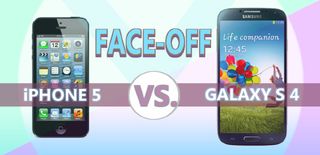
The rivalry between Apple and Samsung has mushroomed into an all-out war, and the brands' flagship smartphones are its most deadly weapons. On one side, you have the iPhone 5, a device that's Zen-like in its simplicity but also very swift and light on its feet. And on the other side, you have the Galaxy S4, which hopes to overwhelm Apple with a bigger screen and a steady barrage of features.
Yes, Samsung's phone is shinier and newer, but that doesn't mean it's necessarily the best choice. We pit the iPhone 5 against the latest Galaxy S4 in 11 hard-fought battles to determine which device reigns supreme.
Design
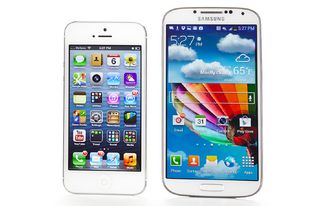
Even several months after its debut, the iPhone 5 remains a status symbol. We're talking a glass-and-aluminum beauty that's incredibly light (3.9 ounces), yet solid. The polished chamfered edges, precision- cut speakers and even the button feel are all pretty much perfect. Apple's device is also easy to use with one hand, whereas the Galaxy S4 can be a stretch to reach across the screen with your thumb.

The Galaxy S4 has a more pedestrian plastic aesthetic, but it's certainly an improvement over the S3. The polycarbonate chassis has a sturdier, denser feel than its predecessor. We like the dot pattern on the back of the black version, which looks more sophisticated than the white model. Remove the back — something you can't do on the iPhone 5 — and you'll have access to the replaceable battery and microSD Card slot.
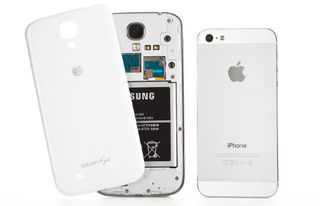
The S4 is fairly light for a 5-inch phone, weighing 4.6 ounces and measuring 0.25 inches thick. That's thinner than the 0.3-inch iPhone 5. However, the S4 is significantly taller and wider. As a result, we found ourselves having to shift the device in our hand to move from the power button to the home button.
Winner: iPhone 5. While we appreciate the removable back cover on the Galaxy S4 and how light it is given its large display, the iPhone 5 offers a far more elegant, striking and user-friendly design.
Display

Size isn’t everything, but it definitely helps that the Galaxy S4 has an inch on the iPhone 5. The 5-inch Super AMOLED display makes the iPhone’s 4-inch LCD look relatively cramped. For instance, text on Laptopmag.com was easier to read using the S4 without needing to zoom in, and the phone displayed an additional headline and blurb. In addition, watching movies and video clips felt more immersive on the S4, such as the “Man of Steel” trailer.
The S4 also has a leg up on the iPhone 5 in terms of resolution, offering 1920 x 1080 pixels or 441 pixels per inch. The iPhone 5 offers a fairly sharp picture at 1136 x 640 pixels, but it trails the S4 with 326 ppi.
When we looked at the same full HD image of “The Man of Steel,” we could make out finer mesh details in Superman's new uniform on the S4, and his red cape popped more. We also appreciated the greater contrast in his face, which made the Son of Krypton's cleft chin more pronounced. The iPhone 5's image was brighter with a cooler color cast.
Where the S4 falls behind the iPhone 5 is brightness. Apple’s handset registered 535 lux on our light meter, compared with 446 lux for the Galaxy S4. When viewed outdoors, the S4’s display was harder to read, especially in direct sunlight.
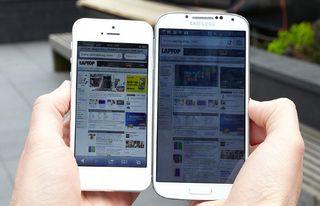
Winner: Galaxy S4. While iPhone 5’s screen is easier to read outdoors, the Galaxy S4’s display wins because of its size and resolution advantage, as well as its better contrast.
Audio
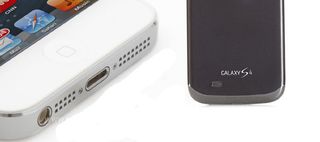
The back-mounted speaker on the Galaxy S4 doesn’t look like much, but it delivers a pretty good punch. Whether we were playing the Lumineers' “Ho Hey,” or “Pumped Up Kicks” from Foster the People, we could easily hear the S4 from across a medium-size office. We had to strain a bit more to hear the iPhone 5, though its dual speakers offer a warmer, richer tone. However, it’s easier to muffle the sound on the iPhone 5 when playing games in Landscape Mode because its speakers are on the bottom of the phone.
Winner: Samsung Galaxy S4. Samsung’s device offers louder sound and better speaker placement.
Interface
If you've ever used an iPhone or iPod touch, the iPhone 5's interface will be instantly familiar and intuitive. The device uses the same icon-driven UI as its predecessors, complete with the ability to easily create folders by dragging and dropping app shortcuts on top of each other. It's not exciting, but it works.
Swiping down from the top of the screen reveals Notification Center, where you can see the latest weather conditions, upcoming appointments, scrolling stocks, and alerts for apps such as email and Twitter. We also like the dedicated Tap to Tweet and Tap to Post (Facebook) buttons at the top of Notification Center.
Another highlight of the iPhone's interface is Spotlight search, made accessible by swiping right while on the first home screen. Here you can search almost anything that might be on your phone: apps, emails, messages, contacts, calendar entries, media, notes and reminders. Google search on the S4 is more limited, letting us find apps, contacts and media, but not individual messages or appointments.
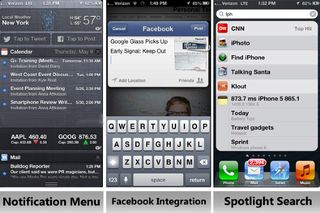
The Galaxy S4's TouchWiz interface lets you do a lot more in less taps. For instance, when you swipe down from the top, you can toggle everything from Wi-Fi and Bluetooth to special features like Air Gesture and Smart Scroll. You can even customize which quick setting buttons appear at the top of the notification panel. We also love the brightness slider control in this panel, a setting that's buried on the iPhone.
The S4's customization advantage extends to the lock screen, where you can set your own unlock shortcuts to specific apps. The iPhone 5 limits you to the camera or any app that pushes a notification to the lock screen.
The fact that the S4 has separate home screens and app screens will be confusing to potential iPhone switchers, but we do like the prominent weather widget on the main home screen, and you can add your own. The iPhone 5 lacks widgets.
The S4 really outshines the iPhone when it comes to multitasking. While the iPhone 5 sticks to the same old double-tap-to-see-icons at the bottom of the screen for switching apps, the S4 gives users a live preview when you long-press the home button.
Even better, long-pressing the back button presents a Multi Window Menu, enabling you to run two apps on the S4's screen at the same time. For instance, you can check your Facebook feed while scanning your inbox or watching a YouTube video.

Winner: Samsung Galaxy S4. Yes, the iPhone 5 is easier to use, but the Galaxy S4's faster access to settings, widget support and superior multitasking make Samsung's device a lot more versatile.
Keyboard
Long the gold standard of touch-screen keyboards, the iPhone 5's layout is simple and effective. Despite having a smaller screen than the Galaxy S4, we typed quickly and accurately. We noticed less lag on the iPhone versus Samsung’s layout.
However, only the S4 offers a dedicated number row, which makes it a lot easier to enter passwords. You can also long-press multiple letters to enter symbols without toggling to a separate menu, from “&” to punctuation.

The S4 pulls ahead even further with the help of SwiftKey, whose technology powers Samsung’s keyboard. The phone offers next word predictions, which speeds up text entry, as well as trace typing, which makes it easier to peck out that message with one hand. Plus, only the S4 offers haptic feedback. Last but not least, voice typing is a lot faster on the Samsung because it works offline. Siri does not.
Winner: Samsung Galaxy S4. A dedicated number row and smart word prediction gives Samsung the win in this round.
Camera
On the feature front, the S4's camera wipes the floor with the iPhone 5. While Apple's device keeps things simple with Panorama and HDR, the S4 offers a multitude of options to make picture-taking more fun and convenient.
Samsung's phone features a Drama Shot Mode for action shots, an Eraser Mode for eradicating photo bombers and a Dual Shot Mode for using the front and back cameras at the same time, great for inserting yourself in a picture postcard. We really like how easy Samsung makes it to switch camera modes, complete with helpful descriptions.

Other camera options unique to the S4 is an Auto Night Mode for low-light shots, Best Face for creating the optimal group shot, Animated photo for animating parts of the picture and slow and fast motion video.
In terms of photo quality, the iPhone 5 impressed us more, despite the fact that its camera offers less resolution that the Galaxy S4 (8 MP versus 13 MP). In one test shot of a fountain, the S4 blew out details that the iPhone 5 picked up, such as the darker flecks in the stone at the front edge of the fountain, as well as where the water drops landed. The iPhone’s shot also offered better contrast.

In another shot taken of flowers, the iPhone 5’s image produced more detail in the petals and richer colors. However, the Galaxy S4’s shot was brighter and more evenly lit, especially toward the roots. In another close-up shot of a stone pot, the S4’s image delivered more detail while the iPhone 5 seemed to have more trouble dealing with the sun (off to the left).
Indoors, a shot taken of the "Sesame Street" character Grover and some other objects on a shelf looked sharper on the iPhone, but the S4’s image had more accurate colors. The white background looked a bit yellow on the iPhone 5.
For our final still image comparison, we shot the same painting indoors in low light both with and without the flash (in Auto Mode). The iPhone 5 won both contests, thanks to a brighter low-light image and a crisper shot taken with the flash engaged.
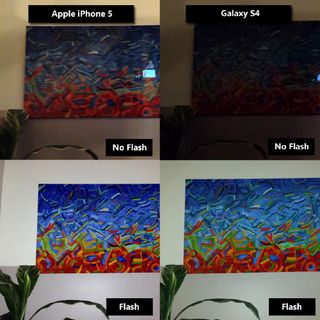
Last but not least, we shot the same footage of New York City traffic with both phones in 1080p mode. While the S4’s footage looked brighter, the iPhone 5’s clip was less shaky and offered more detail, such as the dents in a passing van.
Winner: Draw. The iPhone 5 generally takes better looking photos, but the Galaxy S4 lets you get more creative with its wide array of features.
Specs and Performance
Samsung comes to this fight armed with Qualcomm's latest quad-core 1.9-GHz Snapdragon 600 processor and 2GB of RAM, while the iPhone 5 packs Apple's 1.3-GHz A6 processor and 1GB of RAM.
To gauge the performance of these two smartphones, we first ran Geekbench 2, which measures processor and memory performance. The iPhone 5 scored 1,660, compared with the Galaxy S4's 3,177. So Samsung's flagship is nearly twice as fast on this test.
On Passmark, which evaluates everything from CPU and disk performance to memory and 2D and 3D graphics, the iPhone 5 scored a higher 3,874 versus 3,414 for the Galaxy S4. To be fair, though, Passmark hasn't been optimized for the iPhone 5's larger screen, so it ran in a smaller window. In other words, the test likely wasn't as taxing as it could have been.
We then measured graphics performance using the intense GFXBench app for both Android and iOS. On the T-Rex HD Offscreen Fixed timestep test, which measures framerates during an animated scene of a T. rex chasing someone riding a motorbike through the jungle, the S4 notched 15 fps, compared with 6.6 fps for the iPhone 5.

The iPhone 5 fared better on the Web-based Sunspider 1.0 JavaScript test, scoring 873.7 milliseconds. The S4 was well behind at 1364.5 ms. Lower scores are better in this test.

In everyday usage, the iPhone 5 proved to be the snappier performer. For instance, the iPhone 5 was faster when unlocking both phones to the camera app, as well as opening an app like email. We also noticed that the Galaxy S4 was slower to pop up the keyboard when we tapped a text field, such as the address bar in the browser. However, the two devices were neck and neck when exiting an app to the home screen (once we disabled the S Voice shortcut for the Home button).
So what about storage? The Galaxy S4 has an advantage on paper because it offers a microSD Card slot for expansion, which the iPhone 5 lacks. On the other hand, all of the S4's features take up a fair amount of room out of the box. About 8.49GB of 16GB is available to the user, or 55 percent, while the iPhone 5 gives buyers 77 percent of its available memory. And while you can get up to 80GB with a memory card on the S4, it can't be used for apps.
Winner: Draw. Within applications, you'll enjoy the Galaxy S4's quad-core advantage, but the iPhone 5 exhibits considerably less lag when navigating the device.
Special Features
With iOS 6, the iPhone 5 gained some new capabilities (at least for Apple fans), starting with the addition of Facebook integration. It’s a cinch to share articles, photos and more with your favorite social network. Speaking of sharing, Shared Photo Streams creates a mini social network of sorts for swapping photos with close friends and family, complete with integrated comments.

Siri also gets an IQ boost with the addition of sports scores and stats, as well as movie info. For instance, we asked about movie reviews for “Iron Man 3,” and Siri returned the Rotten Tomatoes score. Through a partnership with OpenTable, Siri will even let you book a table at that restaurant you’ve been dying to try.
Other iOS 6 features aren’t as fulfilling. Apple Maps, for example, doesn’t offer transit directions within the app; instead, it directs you to third-party apps. Passbook is marginally useful, aggregating loyalty cards, boarding passes and other items for easy access, but it lacks mobile payment functionality (at least for now).
The Galaxy S4 runs circles around the iPhone 5 when it comes to features, starting with how you interact with the device. Air Gestures lets you flip through photos or answer the phone just by waving your hand in front of the S4 (though you have to be close to the screen). With Smart Scroll, you can also scroll through a Web article just by tilting the device in your hand or tilting your head. This worked most of the time, but proved finicky at others.

Air View is a pretty nifty feature on the S4, which enables you to preview content (such as an email) by hovering your finger just above the display.
With the WatchOn app, the S4 leverages its built-in IR blaster to control your TV. The app also recommends shows you may want to watch, and even integrates with services like Netflix.
Still not impressed with the S4's versatility? It also offers S Translate for translating multiple languages (speech and text) and an S Health app for keeping track of your fitness.
Winner: Samsung Galaxy S4. Samsung's flagship phone has so many features, this round isn't even close.
Apps and Content
Samsung is getting serious about competing with iTunes by offering its own Samsung Hub. From one place, you can buy music, video, books and games with your Samsung account. As you’d expect, you can rent or buy flicks such as “Guilt Trip” and “Jack Reacher” for $5.99 or $14.99.

Still, the iTunes store offers a much deeper selection of content. For example, the Samsung store was missing the top two New York Times Bestsellers that iTunes stocked during our testing, David Baldacci’s “The Hit” and Nora Roberts’ “Whiskey Beach.” The Hub was also missing Lady Antebellum’s new “Golden” album.

On the app front, the Google Play store stocks more than 700,000 apps (some for tablets, but most for phones), compared with more than 475,000 apps for the iPhone. However, numbers aren’t everything. Because of developer support, the iPhone tends to get some of the most compelling apps first, such Vine, Tempo (a great calendar app), Infinity Blade 2, Dark Sky and Mailbox. All of these are exclusive to iOS, at least for now.
However, some Android apps demonstrate that Google’s platform lets you go further in terms of customizing your device, such as the Chat Heads feature in the new Facebook app, and the multitude of Launcher apps.
Winner: iPhone 5. The combination of iTunes’ huge content head start and the fact that many of the hottest apps hit iOS first make the iPhone 5 the winner of this round.
Battery Life

It's a good thing the Galaxy S4's battery is replaceable. Thus far, we've tested both the Sprint and AT&T versions of Samsung's flagship, and its 2,600 mAh battery hasn't impressed.
On the LAPTOP Battery Test, which involves continuous Web surfing over 4G LTE on 40 percent brightness, the Sprint version of the S4 lasted 5 hours and 49 minutes, which is below the 6:06 smartphone average. On Power Saver Mode, which throttles the CPU and ramps down other settings, the S4 lasted 6:05. We saw slightly worse results from the AT&T version of this phone, with respective runtimes of 5:13 and 5:54.
On the same test using the Verizon version of the iPhone 5, we saw 7 hours and 13 minutes of endurance, or more than an hour longer. Granted, the iPhone 5 doesn't have a removable battery, but there are at least a half dozen battery extender cases available for those looking for more juice.
Winner: iPhone 5. Apple's device lasts considerably longer on a charge.
Accessories

This round used to be a walk in the park for the iPhone, but now lots of companies are tapping into Samsung's growing market share. For instance, there are already dozens of cases available for the Galaxy S4. Samsung's own Flip View Cover is pretty neat because it lets you glance at alerts and other vital info without opening the cover.
Other compelling options include an extra battery charging kit (great for keeping a spare handy), a wireless charging cover and pad, and a waterproof S Band that syncs with the S4's S Health app to keep tabs on your sleep and fitness. Samsung will also sell a heart rate monitor and scale to go with S Health.
Best Buy, for example, lists 64 accessories for the Galaxy S4, including screen protectors, car chargers, holsters with kickstands, HDMI adapters, armband cases and more. Of course, the S4 works with any Bluetooth speakers or headphones.
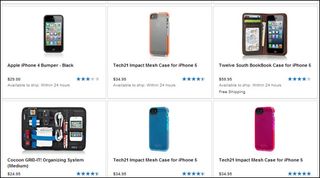
Partly because the iPhone 5 has been available longer and partly because of Apple's larger ecosystem, there are tons of accessories available for this device. Best Buy lists 323 accessories, about triple the amount for the S4. The iPhone 5's universe of options includes everything from cases and camera add-on lenses to car mounts and stands.
Winner: Draw. While Apple and its partners offer more options for the iPhone 5, you can already find practically everything you need to trick out your Galaxy S4 from Samsung itself or through third parties. And a lot more stuff is on the way.
Overall

The decision between an iPhone 5 and Galaxy S4 comes down to a few factors. If you prefer a bigger screen, going with Samsung's phone is an easy call, as it makes everything from surfing the Web and playing games more enjoyable. Plus, unlike Apple’s device, you can even run two apps on the display at once.
The Galaxy S4 also trumps the iPhone 5 in the features department. Some of its capabilities come off as gimmicky, such as scrolling with your eyes, but others can come in quite handy, such as Air Gestures, S Health and TV remote functionality. We also love all of the fun camera features, even though we prefer the iPhone's picture quality.
The iPhone 5 has a lot of the same advantages now as when we did our last face-off between the iPhone 5 and Galaxy S III. Apple’s device offers a better design, a brighter display and snappier performance when navigating the device. There’s less lag here. The iPhone 5 also lasts longer on a charge (though it lacks a removable battery) and has a better selection of content and apps.
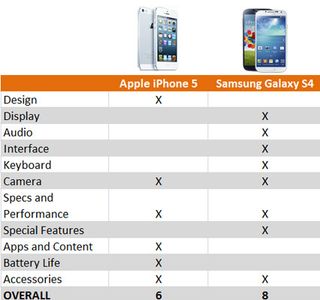
Overall, we give the edge to the Galaxy S4 because it’s a smartphone that just does a lot more out of the box; it feels like a more complete user experience. Now it’s up to Apple to catch up with iOS 7 and its next iPhone.
Follow Mark Spoonauer at @mspoonauer. Follow Tom's Guide at @tomsguide, on Facebook and on Google+.
Sign up to get the BEST of Tom's Guide direct to your inbox.
Here at Tom’s Guide our expert editors are committed to bringing you the best news, reviews and guides to help you stay informed and ahead of the curve!
Mark Spoonauer is the global editor in chief of Tom's Guide and has covered technology for over 20 years. In addition to overseeing the direction of Tom's Guide, Mark specializes in covering all things mobile, having reviewed dozens of smartphones and other gadgets. He has spoken at key industry events and appears regularly on TV to discuss the latest trends, including Cheddar, Fox Business and other outlets. Mark was previously editor in chief of Laptop Mag, and his work has appeared in Wired, Popular Science and Inc. Follow him on Twitter at @mspoonauer.
